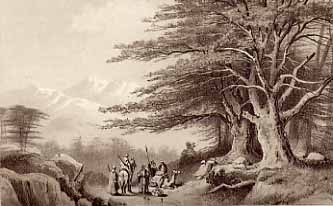
The Land and the Book by William Thomson revels in the open countryside, where the author would have the pilgrim join in under the stars, especially when the bed is stretched out in a grove of cedars on Mt. Lebanon. Here is the missionary’s description of the magic of the cedars over 150 years ago.
Have you ever visited these cedars?
Many times. They are situated high up on the western slope of Lebanon, ten hours south-east from Tripoli. Besherrah is directly west, in the romantic gorge of the Khadusha, two thousand feet below them, and Ehden is three hours distant on the road to Tripoli. In no other part of Syria are the mountains so Alpine, the proportions so gigantic, the ravines so profound and awful. You must not leave the country without visiting the cedars. There are several routes to them, and all wild, exciting, delightful. One of the most romantic is to climb Lebanon from Beirut quite to the base of Jebel Knuseh, then wind northward around the heads of the stupendous gorges made by the rivers of Beirut, Antelas, Dog River, Nahr Ibrahim, Nahr el Jous, and the Khadusha. I have repeatedly followed that wildest of routes, with or without a path, as the case might be, clinging to the shelving declivities midway to heaven, with a billowy wilderness of rocks and ravines sinking away westward down to the sea. The very thought of it at this minute is positively intoxicating. The platform where the cedars stand is more than six thousand feet above the Mediterranean, and around it are gathered the very tallest and greyest heads of Lebanon. The forest is not large, not more than five hundred trees, great and small, grouped irregularly on the side of shallow ravines, which mark the birth-place of the Khadsha, or Holy River.
But, though the space covered by them does not exceed half a dozen acres, yet, when fairly within the grove, and beneath the giant arms of those old patriarchs of a hundred generations, there comes a solemn hush upon the soul as if by enchantment. Precisely the same sort of magic spell settles on the spirits, no matter how often you repeat your visits. But it is most impressive in the night. Let us by all means arrange to sleep there. The universal silence is almost painful. The grey old towers of Lebanon, still as a stone, stand all around, holding up the stars of heaven to look at you; and the trees gather like phantoms about you, and wink knowingly, or seem to, and whisper among themselves you know not what. You become suspicious, nervous, until, broad awake, you find that it is nothing but the flickering of your drowsy fire, and the feeble flutter of bats among the boughs of the trees. A night among the cedars is never forgotten; the impressions, electrotyped, are hid away in the inner chamber of the soul, among her choicest treasures, to be visited a thousand times with never-failing delights.¦
I counted four hundred and forty three, great and small; and this cannot be far from the true number. This, however, is not uniform. Some are stuck down by lightning, broken by enormous loads of snow, or torn to fragments by tempests. Even the sacrilegious axe is sometimes lifted against them. But, on the other hand, young trees are constantly springing up from the roots of old trees, and from seeds of ripe cones. I have seen these infant cedars in thousands just springing up from the soil; but, as the grove is wholly unprotected, and greatly frequented both by men and animals, they are quickly destroyed. This fact, however, proves that the number might be increased ad libitum. Beyond a doubt, the whole of these upper terraces of Lebanon might again be covered with groves of this noble tree, and furnish timber enough not only for Solomon’s temple and the house of the forest of Lebanon, but for all the houses along this coast. But, unless a wiser and more provident government control the country, such a result can never be realized; and, indeed, the whole forest will slowly die out under the domination of the Arab and Turk. Even in that case the tree will not be lost. It has been propagated by the nut or seed in many parks in Europe, and there are more of them within fifty miles of London than on all Lebanon.
We have seen larger trees every way, and much taller, on the banks of the Ohio, and the loftiest cedar might take shelter under the lowest branches of California’s vegetable glories. Still, they are respectable trees. The girth of the largest is more than forty-one feet; the height of the highest may be one hundred. These largest, however, part in two or three only a few feet from the ground. Their age is very uncertain, nor are they ready to reveal it to others who have an uneasy consciousness of length of days. Some of our missionary band, who have experience in such matters, and confidence in the results, have counted the growth (as we Western people call the annual concentric circles) for a few inches into the trunk of the oldest cedar, and from such data carry back its birth three thousand five hundred years. It may be so.
Excerpt from William M. Thomson, The Land and the Book; or, Biblical Illustrations Drawn from the Manners and Customs, the Scenes and Scenery of the Holy Land. London: T. Nelson and Sons, 1901, pp. 197-199. [Original. 1859]